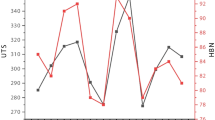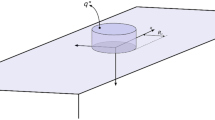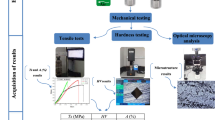Abstract
Enhanced penetration potential of activated TIG (A-TIG) welding process over conventional TIG welding has made the former process preferred for welding in recent times. The quality and shape of the weld in A-TIG are not only influenced by the chemical composition of the flux, but also by the selection of welding parameters. As a variety of process parameters influence the results, a proper understanding of process performance and identification of favorable welding conditions (optimum setting of process parameters) are indeed necessary to improve quality. The present work highlights the application potential of multi-response optimization route by integrating response surface methodology with the JAYA optimization algorithm, particularly for optimizing the A-TIG welding process parameters for carbon steels. Systematic experiments were carried out considering welding current, arc gap and travel speed as input parameters, whereas the depth of penetration, depth-to-width ratio, heat input and total width of heat-affected zone were considered as output performance characteristics. An attempt has been made in the current study to recognize the precise setting of selected input process parameters for simultaneous optimization of the aforementioned performance characteristics. The result of JAYA algorithm has also been compared with the teaching–learning-based optimization technique. While fairly similar results were achieved, the implementation of JAYA algorithm was computationally efficient. Experimental validation of the single-objective as well as multi-objective optimization results indicates that the empirical models for the response parameters as well as the proposed optimization framework are accurate tools in A-TIG welding research.












Similar content being viewed by others
References
Lakshminarayanan A, Annamalai V, Elangovan K (2015) Identification of optimum friction stir spot welding process parameters controlling the properties of low carbon automotive steel joints. J Mater Res Technol 4:262–272
Tathgir S, Bhattacharya A (2016) Activated-TIG welding of different steels: influence of various flux and shielding gas. Mater Manuf Process 31(3):335–342
Burgardt P, Heiple C (1986) Interaction between impurities and welding variables in determining GTA weld shape. Weld J 65(6):150
Heiple C, Roper J (1981) Effects of minor elements on GTAW fusion-zone shape. Rockwell International Corp., Golden, CO (USA). Rocky Flats Plant
Lambert J (1991) Cast-to-cast variability in stainless steel mechanized GTA welds. Weld J 70(5):41–52
Vasudevan M, Arunkumar V, Chandrasekhar N, Maduraimuthu V (2010) Genetic algorithm for optimisation of A-TIG welding process for modified 9Cr–1Mo steel. Sci Technol Weld Join 15(2):117–123
Vasudevan M, Bhaduri A, Raj B, Rao KP (2007) Genetic-algorithm-based computational models for optimizing the process parameters of A-TIG welding to achieve target bead geometry in type 304 L (N) and 316 L (N) stainless steels. Mater Manuf Process 22(5):641–649
Vora JJ (2019) Insights into the flux-assisted TIG welding processes. In: Vora JJ, Badheka VJ (eds) Advances in welding technologies for process development, vol 1. CRC Press, Taylor and Francis, Boca Raton. https://doi.org/10.1201/9781351234825-11
Tseng K-H (2013) Development and application of oxide-based flux powder for tungsten inert gas welding of austenitic stainless steels. Powder Technol 233:72–79
Shyu S, Huang H, Tseng K, Chou C (2008) Study of the performance of stainless steel A-TIG welds. J Mater Eng Perform 17(2):193–201
Tseng K-H, Hsu C-Y (2011) Performance of activated TIG process in austenitic stainless steel welds. J Mater Process Technol 211(3):503–512
Arivazhagan B, Vasudevan M (2015) Studies on A-TIG welding of 2.25 Cr-1Mo (P22) steel. J Manuf Process 18:55–59
Vora JJ, Patel VV, Suthar SH, Naik A, Kundal D, Patel R, Das S (2017) Investigation on the activated TIG welding of Cr-Mo-V steels. Paper presented at the 70th IIW international conference (IIW 2017) at Shanghai, Shnaghai, China
Naik A, Kundal D, Suthar SH, Vora JJ, Patel VV, Das S, Patel R (2018) Investigation on the activated TIG welding of Cr-Mo-V steels. In: A Mahajan, BA Modi, Patel P (eds) Technology drivers: engine for growth proceedings of the 6th Nirma University international conference on engineering (Nuicone 2017), November 23–25, 2017, Ahmedabad, India, vol 1. CRC Press, Taylor & Francis, Boca Raton, pp 243–248
Chern T-S, Tseng K-H, Tsai H-L (2011) Study of the characteristics of duplex stainless steel activated tungsten inert gas welds. Mater Des 32(1):255–263
Vaishnani S, Sadhu J, Suthar S, Vora JJ, Patel V (2017) Development of activated TIG welding technology for duplex stainless steel 2205 for achieving sustainability. Paper presented at the 4th international conference on industrial engineering (ICIE 2017), Surat, Gujarat
Ramkumar KD, Bajpai A, Raghuvanshi S, Singh A, Chandrasekhar A, Arivarasu M, Arivazhagan N (2015) Investigations on structure–property relationships of activated flux TIG weldments of super-duplex/austenitic stainless steels. Mater Sci Eng, A 638:60–68
Muhammad N, Manurung YH, Jaafar R, Abas SK, Tham G, Haruman E (2013) Model development for quality features of resistance spot welding using multi-objective Taguchi method and response surface methodology. J Intell Manuf 24(6):1175–1183
Zhao D, Wang Y, Sheng S, Lin Z (2014) Multi-objective optimal design of small scale resistance spot welding process with principal component analysis and response surface methodology. J Intell Manuf 25(6):1335–1348
Katherasan D, Elias JV, Sathiya P, Haq AN (2014) Simulation and parameter optimization of flux cored arc welding using artificial neural network and particle swarm optimization algorithm. J Intell Manuf 25(1):67–76
Ajith P, Barik BK, Sathiya P, Aravindan S (2015) Multiobjective optimization of friction welding of UNS S32205 duplex stainless steel. Defence Technology
Anand K, Barik BK, Tamilmannan K, Sathiya P (2015) Artificial neural network modeling studies to predict the friction welding process parameters of Incoloy 800H joints. Eng Sci Technol Int J 18:394–407
Sathiya P, Aravindan S, Haq AN, Paneerselvam K (2009) Optimization of friction welding parameters using evolutionary computational techniques. J Mater Process Technol 209(5):2576–2584
Chandrasekhar N, Vasudevan M (2010) Intelligent modeling for optimization of A-TIG welding process. Mater Manuf Process 25(11):1341–1350
Subashini L, Madhumitha P, Vasudevan M (2012) Optimisation of welding process for modified 9Cr-1Mo steel using genetic algorithm. Int J Comput Mater Sci Surf Eng 5(1):1–15
Chokkalingham S, Chandrasekhar N, Vasudevan M (2010) Artificial neural network modeling for estimating the depth of penetration and weld bead width from the infra red thermal image of the weld pool during A-TIG welding. In: Simulated evolution and learning. Springer, pp 270–278
Chokkalingham S, Chandrasekhar N, Vasudevan M (2012) Predicting the depth of penetration and weld bead width from the infra red thermal image of the weld pool using artificial neural network modeling. J Intell Manuf 23(5):1995–2001
Chandrasekhar N, Vasudevan M, Bhaduri A, Jayakumar T (2015) Intelligent modeling for estimating weld bead width and depth of penetration from infra-red thermal images of the weld pool. J Intell Manuf 26(1):59–71
Popović O, Cvetković-Prokić R, Burzić M, Milutinović Z (2010) The effect of heat input on the weld metal toughness of surface welded joint. In: Proceedings of 14th international research/expert conference on trends in the development of machinery and associated technology: TMT, 2010
Datta S, Sahu RK, Mahapatra SS, Biswas A, Majumdar G (2014) Optimisation of percent dilution and HAZ width of submerged arc weldment using Taguchi philosophy coupled with fuzzy inference system. Int J Product Qual Manag 13(4):430–449
Singh A, Datta S, Mahapatra SS, Singha T, Majumdar G (2013) Optimization of bead geometry of submerged arc weld using fuzzy based desirability function approach. J Intell Manuf 24(1):35–44
Rao R, Savsani V, Vakharia D (2012) Teaching–learning-based optimization: an optimization method for continuous non-linear large scale problems. Inf Sci 183(1):1–15
Rao R, Savsani VJ, Vakharia D (2011) Teaching–learning-based optimization: a novel method for constrained mechanical design optimization problems. Comput Aided Des 43(3):303–315
Rao R, Kalyankar V (2013) Parameter optimization of modern machining processes using teaching–learning-based optimization algorithm. Eng Appl Artif Intell 26(1):524–531
Rao R, Kalyankar V (2011) Parameters optimization of advanced machining processes using TLBO algorithm. EPPM, Singapore 20:21–31
Rao R, Kalyankar V (2013) Multi-pass turning process parameter optimization using teaching–learning-based optimization algorithm. Scientia Iranica 20(3):967–974
Rao R, Kalyankar V, Waghmare G (2014) Parameters optimization of selected casting processes using teaching–learning-based optimization algorithm. Appl Math Model 38(23):5592–5608
Pawar P, Rao RV (2013) Parameter optimization of machining processes using teaching–learning-based optimization algorithm. Int J Adv Manuf Technol 67(5–8):995–1006
Patel P, Nakum B, Abhishek K, Kumar VR (2018) Machining performance optimization during plasma arc cutting of AISI D2 steel: application of FIS, nonlinear regression and JAYA optimization algorithm. J Braz Soc Mech Sci Eng 40(4):240
Toğan V (2012) Design of planar steel frames using teaching–learning based optimization. Eng Struct 34:225–232
Gadhvi B, Savsani V (2014) Passive suspension optimization using teaching learning based optimization and genetic algorithm considering variable speed over a bump. In: ASME 2014 international mechanical engineering congress and exposition, 2014. American Society of Mechanical Engineers, pp V04AT04A018–V004AT004A018
Naik A, Satapathy SC, Parvathi K (2012) Improvement of initial cluster center of c-means using teaching learning based optimization. Procedia Technol 6:428–435
Satapathy SC, Naik A (2011) Data clustering based on teaching-learning-based optimization. In: Swarm, evolutionary, and memetic computing. Springer, pp 148–156
Rao R, More K, Taler J, Ocłoń P (2016) Dimensional optimization of a micro-channel heat sink using Jaya algorithm. Appl Therm Eng 103:572–582
Abhishek K, Kumar VR, Datta S, Mahapatra SS (2017) Application of JAYA algorithm for the optimization of machining performance characteristics during the turning of CFRP (epoxy) composites: comparison with TLBO, GA, and ICA. Eng Comput 33(3):457–475
Vora JJ, Badheka VJ (2017) Experimental investigation on microstructure and mechanical properties of activated TIG welded reduced activation ferritic/martensitic steel joints. J Manuf Process 25:85–93. https://doi.org/10.1016/j.jmapro.2016.11.007
Vora JJ, Badheka VJ (2016) Experimental investigation on effects of carrier solvent and oxide fluxes in activated TIG welding of reduced activation ferritic/martensitic steel. Int J Adv Mech Automob Eng 3:5. https://doi.org/10.15242/IJAMAE.AE0316011
Vora JJ, Badheka VJ (2016) Improved penetration with the use of oxide fluxes in activated TIG welding of low activation ferritic/martensitic steel. Trans Indian Inst Met 69(9):1755–1764. https://doi.org/10.1007/s12666-016-0835-6
Vora JJ, Badheka VJ (2015) Experimental investigation on mechanism and weld morphology of activated TIG welded bead-on-plate weldments of reduced activation ferritic/martensitic steel using oxide fluxes. J Manuf Process 10:11–12. https://doi.org/10.1016/j.jmapro.2015.07.006
Dhandha KH, Badheka VJ (2015) Effect of activating fluxes on weld bead morphology of P91 steel bead-on-plate welds by flux assisted tungsten inert gas welding process. J Manuf Process 17:48–57
Box GE, Behnken DW (1960) Some new three level designs for the study of quantitative variables. Technometrics 2(4):455–475
Ibrahim HM, Elkhidir EE (2011) Response surface method as an efficient tool for medium optimisation. Trends Appl Sci Res 6(2):121
Vora JJ (2017) Development of flux assisted tungsten inert gas welding process for low activation ferritic martensitic steel. Pandit Deen Dayal Petroleum University, Gandhinagar
Acknowledgements
The welding setup used for the welding trials was sponsored by BRFST via project number NFP-08/MAT/1. Authors would like to acknowledge them. Authors would also like to acknowledge the help and support provided by Mr. Parth Prajapati and Mr. Rakesh Chaudhari for the optimization studies. We would also like to thank B.Tech students who extended their help in experimentation. Lastly, the editors and reviewers for the paper are kindly acknowledged for their constructive comments which enhanced the quality of the research paper.
Author information
Authors and Affiliations
Corresponding author
Additional information
Technical Editor: Lincoln Cardoso Brandão.
Publisher's Note
Springer Nature remains neutral with regard to jurisdictional claims in published maps and institutional affiliations.
Rights and permissions
About this article
Cite this article
Vora, J.J., Abhishek, K. & Srinivasan, S. Attaining optimized A-TIG welding parameters for carbon steels by advanced parameter-less optimization techniques: with experimental validation. J Braz. Soc. Mech. Sci. Eng. 41, 261 (2019). https://doi.org/10.1007/s40430-019-1765-0
Received:
Accepted:
Published:
DOI: https://doi.org/10.1007/s40430-019-1765-0




